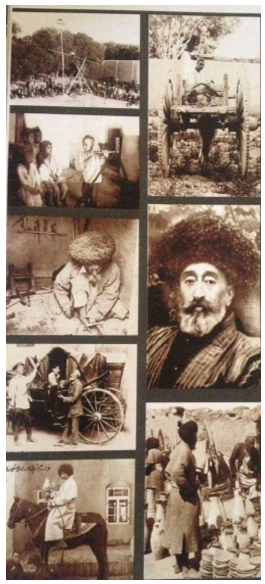Срочная публикация научной статьи
+7 995 770 98 40
+7 995 202 54 42
info@journalpro.ru
The First Uzbek Photographer
Рубрика: Искусствоведение
Журнал: «Евразийский Научный Журнал №6 2017» (июнь, 2017)
Количество просмотров статьи: 2504
Показать PDF версию The First Uzbek Photographer
Камбарова Ойдин Собиржановна
Старший преподаватель кафедры «Промышленный дизайн»
ТГТУ им И.Каримова, Узбекистан, г.Ташкент
Khudaiberge Daviov, the fouder of the atioal art of photography ad documentary cinema was born In Khorezm In 1879 in the family of a court secretary nurmuhammad Divani who was close to the Khan of Khiva Seyeed Muhammad Rahim II, a elighteed ma who wrote euphonious poetry under the pen-name Firuz and set up the first national lithography in the territory of modern Uzbekistan.
It is not surprising that many 19th century technological innovations were embraced in his milieu. It so happened that Divanov , an inquisitive boy, participated in a photo session conducted by someone called Wilhelm Penner , a German from the settlement of Mennonite migrants located near Khiva. This enthusiast of a then innovative art of photography was named Panor-buva (The Lantern Grandpa) by local people for his bulky camera Penner excited young Khudaibergan’s interest in the very process of taking photographs , developing glass negatives and printing pictures. The boy quickly mastered all these complex technological operations and learned to make photographs with a German ZOT camera he received as a gift.

The young photographer went to work at the Khiva mint , and in 1907 was included in a diplomatic mission of Islam Khoja , the Prime Minister of the Khiva Khanate , to St. Petersburg. In the capital of Russian Empire Divanov studied the subtleties of photography with reputable professionals. To complete his training , he was made to stay behind for two month after the diplomatic mission was over. With him Divanov brought back different photo and cinema paraphernalia , including a PATE № 593 movie camera that enabled him to independently produce the first Uzbek documentary featuring Asfandiyar , the Khan of Khiva , riding in a phaeton in 1910. His first films such as “Architectural Monuments of Our Land” (114 m. 1913), “The Sites of Turkestan” (100 m, 1916) and others also survived.
Khudaibergen Divanov became a true promoter of photo and cinema art. He demonstrated his own and foreign- made films in public places in Khiva , introducing his distributed pictures of Khorezmian monuments with clarifying inscriptions in his own hand.
During the existence of the People’s soviet Republic of Khorezm (PSRK), Divanov held the position of a finance minister . All the PSRK banknotes issued in 1922 bear imprint of his seal with an inscription “The Minister of Finance Khudaibergan Divon ogly”. He continued his professional engagement with photography and was seconded to The central Documentary Film Studio to work as a correspondent . Divanov’s film and photo studio was based in Tashkhovli, the former summer palace of the Khan. He repeatedly visited Moscow , bringing films with him; parts of them were included in the issues of “SoyuzKinoJournal” . After his retirement , Divanov organized a photo study group for the students of pedagogical vocational school.
As a member of Mladokhivintsy dissent movement that excited during the years of Stalin’s repressions, he was arrested , denounced as the “enemy of Nations” and executed in Yangiyul prison camp on the 4th of October 1938 (1).

Divanov’s films and photographs breather true love for the people and the history of Khiva. A number of photographs he printed bear Arabic inscriptions made right on glass negatives by the author. The dates of the inscriptions suggest that the young master started his engagement in the art as early as in 1892 — 1893 (1310 — 1311 years of hijra).
The first Divanov’s photographs are ethnographic shots (rope- walkers, or drboz, at the walls of Khiva; hunters with hunting birds; typical Khiva donkey-carts; irrigators clearing the ditches, etc) The quality of his early works is no second to the shots of other contemporary masters of photography. It should be noted that it was in Khiva where the earliest photographs of Turkistan were made by the Russian photographer A. Murenko , member of the 1860 diplomatic mission.
Divanov’s pictures are district in the author’s aspiration to combine an ethnographic approach to shooting with an artistic one. This photographs of historical building of Khiva.
Having become a recognized master, Divanov continued searching for his own signutured , understanding the importance of this work for the future. The re-orientation of the 1920 photography predominantly towards newspaper reporting had an impact on the Khiva photographer too his shoots of that time are similar to the masterpieces of the classics namely A. Shaikhet. B. Khudoyarov, M. Penson (2).
People who knew Khudaibergen Divanov personally say that he “was dignified, courteous and exotically handsome ” (3).
The heritage of the first Uzbek Photographer is understudied. Yet it has already taken its deserved place in the range of the firs-class primery sources for the recreatin of the epoch’s realities, and his name is forever written in annals of the Uzbek art of photography.
Literature
- 125 лет узбекской фотографии Т.
I-III Ташкент, 2005-2007. - Фотовыставка −130—летие со дня рождения основателя узбекского фотоискусства и первого кино-оператора Худайбергена Диванова — Ташкент , 2009.
- Каюмов М. Начало ХХ века . Туркистан . Узбекистан . Первые шага национального кинематографа// Народное слово , 11 Октября 1995 г.









